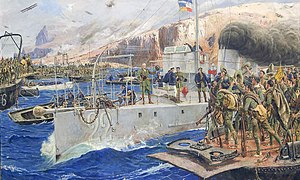
Back إنزال الحسيمة Arabic إنزال لحسيمة ARY Dilestradeg Alhucemas Breton Desembarcament d'Alhucemas Catalan Desembarco de Alhucemas Spanish Al-Hoceimako lehorreratzea Basque Débarquement d'Al Hoceïma French Desembarco de Alhucemas Galician Desembarque de Alhucemas Portuguese Высадка в бухте Алусемас Russian
| Alhucemas landing | |||||||
|---|---|---|---|---|---|---|---|
| Part of the Rif War | |||||||
 Desembarco de Alhucemas, José Moreno Carbonero | |||||||
| |||||||
| Belligerents | |||||||
|
|
| ||||||
| Commanders and leaders | |||||||
|
|
| ||||||
| Strength | |||||||
|
13,000 11 tanks 3 battleships 5 light cruisers 1 protected cruiser 1 aircraft carrier 2 destroyers 2 monitors 7 gunboats 18 patrol boats 6 torpedo boats 4 tugs 58 transport ships 160 aircraft | 9,000 | ||||||
| Casualties and losses | |||||||
| 309 killed and wounded[1] | 700 killed | ||||||
The Alhucemas landing (Spanish: Desembarco de Alhucemas; also known as Al Hoceima landing) was a landing operation which took place on 8 September 1925 at Alhucemas by the Spanish Army and Navy and, in lesser numbers, an allied French naval and aerial contingent, that would put an end to the Rif War. It is considered the first amphibious landing in history involving the use of tanks and massive seaborne air support.[2][3] Alhucemas is seen as a precursor of the Allied amphibious landings in World War II,[4] and the first successful combined operation of the 20th century.[5]
The operations consisted in landing a force of 13,000 Spanish soldiers transported from Ceuta and Melilla by a combined Spanish-French naval fleet. The commander of the operation was the then dictator of Spain, general Miguel Primo de Rivera, and, as the executive head of the landing forces at the beach of Alhucemas bay, general José Sanjurjo, under whose orders were two army brigades from Ceuta and Melilla, led by Leopoldo Saro Marín and Emilio Fernández Pérez, respectively. Among the officers of the Ceuta brigade, there was the then colonel Francisco Franco who, for his leadership of the Spanish Legion troops in this action, was promoted to brigadier general.
- ^ According to the official report, quoted by Martín Tornero (1991).
- ^ Douglas Porch, "Spain's African Nightmare," MHQ: Quarterly Journal of Military History (2006) 18#2 pp 28–37.
- ^ Candil, Anthony J. (2021). Tank Combat in Spain: Armored Warfare During the Spanish Civil War 1936–1939. Casemate. p. 28. ISBN 978-1-61200-971-1.
- ^ "The bloody campaigns of Morocco: a ruin for Spain that conditioned the Civil War". The Canadian. 2021-05-11. Archived from the original on 2021-08-21. Retrieved 2021-08-21.
- ^ Bennassar, Bartolomé (1996). Franco (in French). Éditions Perrin. p. 53. ISBN 978-2-262-01895-5.
© MMXXIII Rich X Search. We shall prevail. All rights reserved. Rich X Search